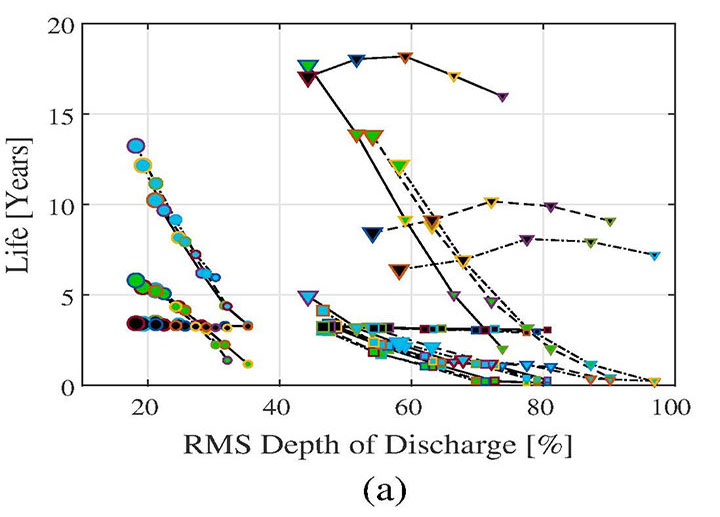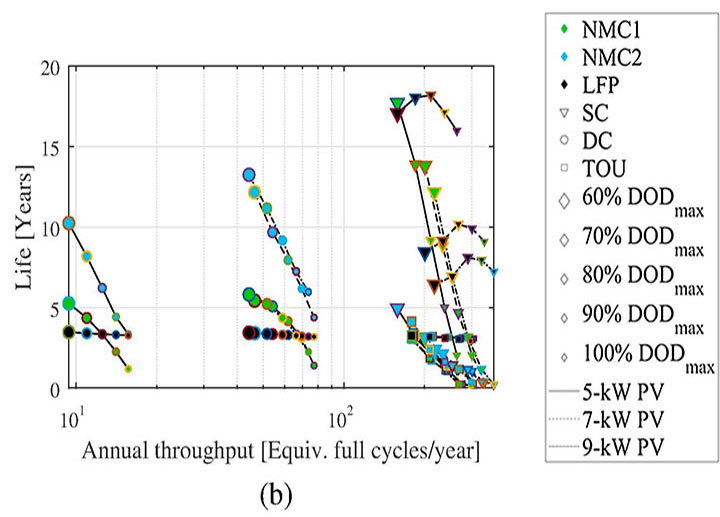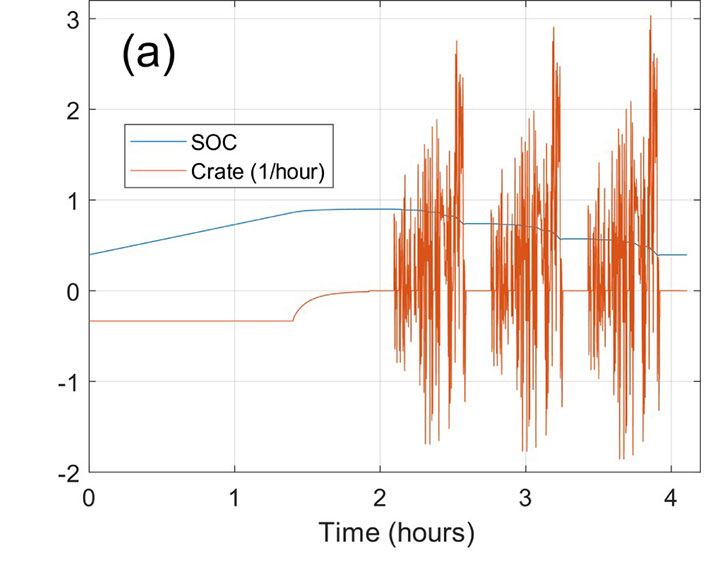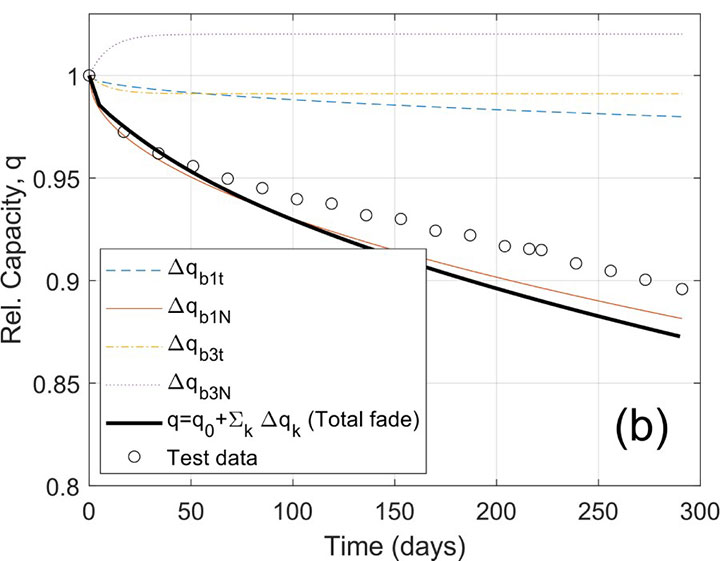BLAST: Battery Lifetime Analysis and Simulation Tool Suite
Pairing NLR's battery degradation modeling with electrical and thermal performance models, the Battery Lifetime Analysis and Simulation Tool (BLAST) suite assesses battery lifespan and performance for behind-the-meter, vehicle, and stationary applications.
Research at NLR is optimizing lithium-ion (Li-ion) batteries used in electric vehicles (EVs) and stationary energy storage applications to extend the lifetime and performance of battery systems. Battery lifetime predictive modeling considers numerous variables that factor into battery degradation during use and storage, including:
- Ambient temperature, cell self-heating, and thermal management
- State-of-charge histories
- Electrical current levels
- Cycle depth and frequency
- Cell balance in packs and modules.
NLR's BLAST suite pairs predictive battery lifetime models with electrical and thermal models specific to simulate energy storage system lifetime, cell performance, or pack behavior.
Tools
BLAST-Lite is a simplified version of NLR's battery lifetime models for a variety of Li-ion battery designs, parameterized from lab data available in Python or MATLAB. BLAST-Lite can be easily implemented into larger techno-economic analysis tools and is currently used by the System Advisor Model and REopt. BLAST-Lite incorporates example load profiles for stationary energy storage or vehicle applications and temperature profiles for U.S. cities.
Access BLAST-Lite in NLR's GitHub repository.
BLAST-Cell simulates the electrical and thermal response of a battery cell to degradation effects throughout its lifetime. Users can simulate a predetermined load profile in MATLAB or input specific current, voltage, power, or resistance controls and limits to simulate the response in MATLAB or Microsoft Excel.
BLAST-Pack simulates the electrical and thermal response of battery modules or packs to degradation effects throughout its lifetime, incorporating the impacts of module and pack architecture on cell performance. BLAST-Pack dramatically reduces simulation time for complex battery systems with a separation of time scales, which distributes electrical load across the pack without requiring nested optimizations. BLAST-Pack also includes optional thermal management or active balancing. Users can simulate a predetermined load profile in MATLAB or input specific current, voltage, power, or resistance controls and limits to simulate the response in MATLAB or Microsoft Excel.
Applications
NLR's BLAST suite provides insight into research or engineering problems related to the design, economics, controls, or thermal management for common use-cases of battery energy storage systems.
Stationary Energy Storage Systems
Researchers can use BLAST tools to simulate the lifetime performance of stationary energy storage applications, such as behind-the-meter residential systems, corner charging stations for EVs, and utility-scale energy storage.


Impact of battery chemistry, application profile, depth-of-discharge, and solar photovoltaic sizing on lifetime of a simulated 10-kWh battery energy storage system in Phoenix, Arizona. Image from Analysis of Degradation in Residential Battery Energy Storage Systems for Rate-Based Use-Cases, Applied Energy (2020)
Electric Vehicles
BLAST tools incorporate realistic lab-based drive-cycles or simulated real-world driving patterns to anticipate EV battery lifetime. Pack-level simulations can also incorporate the effects of heat generation and thermal management on pack performance and lifetime.


WLTP drive-cycle used for validation of Li-ion battery degradation model. (Left) Test results and model predictions using a four-component battery life model. (Right) Image from Lithium-Ion Battery Life Model With Electrode Cracking and Early-Life Break-in Processes, Journal of The Electrochemical Society (2021)
Second-Life and Application Stacking
NLR's collection of battery life models, including BLAST, are able to test data from many cell chemistries, designs, and manufacturers, which allows users to estimate the value of end-of-life batteries if some information on the cell's history is known. This can inform second-life applications for batteries, such as an EV battery being used for stationary energy storage. Similarly, researchers can quantify the battery life impact of application stacking—or using the battery for multiple purposes, such as behind-the-meter storage.
Publications
Learn more about NLR's battery longevity-performance modeling in these publications.
Machine-Learning Assisted Identification of Accurate Battery Lifetime Models With Uncertainty, Journal of the Electrochemical Society (2022)
Analysis of Degradation in Residential Battery Energy Storage Systems for Rate-Based Use-Cases, Applied Energy (2020)
Life Prediction Model for Grid-Connected Li-Ion Battery Energy Storage System, American Control Conference (2017)
Measuring the Benefits of Public Chargers and Improving Infrastructure Deployments Using Advanced Simulation Tools, NLR Conference Paper (2015)
Quantifying the Effect of Fast Charger Deployments on Electric Vehicle Utility and Travel Patterns via Advanced Simulation, NLR Conference Paper (2015)
Will Your Battery Survive a World With Fast Chargers?, NLR Conference Paper (2015)
The Impact of Range Anxiety and Home, Workplace, and Public Charging Infrastructure on Simulated Battery Electric Vehicle Lifetime Utility, Journal of Power Sources (2014)
Thru-Life Impacts of Driver Aggression, Climate, Cabin Thermal Management, and Battery Thermal Management on Battery Electric Vehicle Utility, Journal of Power Sources (2014)
Analyzing the Effects of Climate and Thermal Configuration on Community Energy Storage Systems, NLR Presentation (2013)
Contact
Share
Last Updated Dec. 6, 2025
